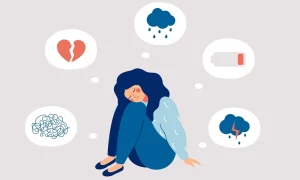What is Trauma?
Trauma is a response to a distressing or life-threatening event. It is an experience that can leave lasting impacts on an individual’s mental, emotional, and physical well-being. Trauma can take many forms, including but not limited to natural disasters, accidents, interpersonal violence, and military combat.
It is a subjective experience that can vary greatly from person to person, and what one individual may experience as traumatic may not necessarily be traumatic for another.
Trauma can result in feelings of fear, helplessness, and loss of control, and can be stored in the body at a cellular level, resulting in physical symptoms such as chronic pain, headaches, and fatigue. It is important to recognize and address trauma in order to promote healing and overall well-being.
Trauma Stored in the Body: How and Why it Happens
Trauma is often stored in the body because it triggers the body’s survival response, commonly known as the fight-or-flight response. The fight-or-flight response is a primitive physiological response that prepares the body to either fight or flee in the face of danger.
This response involves the release of stress hormones, such as adrenaline and cortisol, which can result in physical changes such as increased heart rate, heightened awareness, and tensed muscles. In the case of trauma, the fight-or-flight response is often triggered repeatedly, leading to the accumulation of stress hormones in the body.
There are many reasons why trauma may become stored in the body. These include, but are not limited to:
- Childhood abuse or neglect
- Domestic violence
- Sexual assault
- Accidents or injuries
- Medical procedures
- Military combat
- Natural disasters
- Chronic stress
Where is Trauma Stored in the Body?
Trauma can affect different parts of the body in different ways. For example, trauma that is stored in the muscles can vary from physical trauma, such as injuries or accidents, to emotional trauma, such as abuse or neglect. Chronic tension and pain in the muscles can be a result of the body’s prolonged activation of the fight-or-flight response, which is triggered during traumatic experiences.

Trauma that is stored in the digestive system can result from a range of experiences such as physical trauma, emotional trauma, or chronic stress. Trauma can cause inflammation in the gut, leading to digestive issues such as irritable bowel syndrome (IBS), diarrhea, constipation, abdominal pain, and bloating.
Trauma can affect the nervous system and lead to symptoms such as anxiety, panic attacks, and hypervigilance. This can occur as a result of physical and sexual abuse, natural disasters, and car accidents.
How Trauma Affects the Brain
Trauma can have a significant impact on the brain, particularly on the amygdala and hippocampus. The amygdala is responsible for processing emotional information, while the hippocampus is responsible for memory formation.
In individuals who have experienced trauma, the amygdala may become hyperactive, resulting in heightened emotional responses, while the hippocampus may become damaged, resulting in difficulties with memory and learning.
You May Forget. But Your Body Doesn’t
It is important to recognize that even if an individual has consciously forgotten a traumatic event, their body may still remember it. This is because trauma can become stored in the body at a cellular level, resulting in physical symptoms such as chronic pain, headaches, and fatigue. In order to fully heal from trauma, it is often necessary to address both the psychological and physical aspects of the experience.
Tips & Tools for Releasing Stored Trauma in Your Body
There are a number of techniques that can be used to release stored trauma in the body. These include:
- Mindfulness meditation:
Mindfulness meditation involves paying attention to the present moment without judgment. This can help individuals become more aware of their bodily sensations and emotions, which can help release stored trauma. - Yoga:
Yoga is a mind-body practice that combines physical postures, breathing techniques, and meditation. Practicing yoga can help individuals become more aware of their bodies and release stored trauma. - Breathwork:
Breathwork involves intentionally altering the breath to affect physical and emotional states. This can help release stored trauma by activating the body’s natural healing response. - Massage therapy:
Massage therapy involves the manipulation of the body’s soft tissues, including the muscles and connective tissues. This can help release stored trauma by reducing tension and promoting relaxation. - Somatic Experiencing:
Somatic Experiencing is a form of therapy that focuses on releasing stored trauma by working with bodily sensations and encouraging the body to complete the natural fight-or-flight response that may have been interrupted during the traumatic event. This can help individuals release stored trauma in a safe and controlled manner.
Stress and Health Connection
Chronic stress is a common response to trauma and can have significant impacts on an individual’s physical health. Chronic stress can lead to a weakened immune system, increased inflammation, and an increased risk of chronic diseases such as heart disease and diabetes. Therefore, it is important to address stored trauma in order to reduce chronic stress and promote overall health and well-being.
In conclusion, trauma is a complex experience that can have lasting impacts on an individual’s mental, emotional, and physical well-being. It is important to recognize that trauma can become stored in the body and to address both the psychological and physical aspects of the experience in order to fully heal.
Techniques such as mindfulness meditation, yoga, breathwork, massage therapy, and somatic experiencing can be effective tools for releasing stored trauma in the body. By addressing stored trauma, individuals can reduce chronic stress and promote overall health and well-being.








